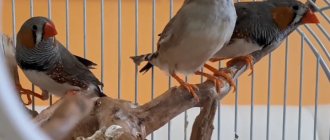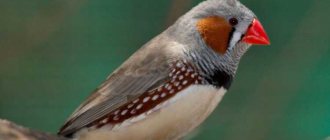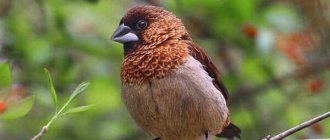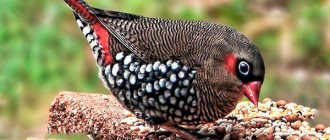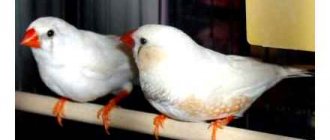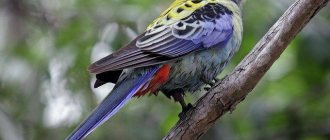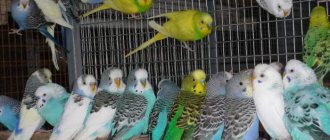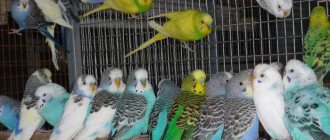- Birds
In the world, in addition to parrots and canaries, there are also birds that can bring joy to the house with just their appearance. These are finch birds. These are very gentle, sweet and unpretentious domestic companions who, when communicating with each other, produce a characteristic, interesting sound reminiscent of a duck quacking. The most ideal bird friend for a large family is the zebra finch - this is one of the varieties of finches from the family of weaver finches. For those who have decided to take up ornithology for the first time or have a cute chick, the zebra finch is the ideal bird.
What a wonderful creature
Finches belong to the family of weaver finches (songbirds from the order Passeriformes, which got their name due to the ability to make nests from flexible blades of grass, separating fibers along the entire length of the leaf and moistening them with saliva), representatives of which can be seen anywhere on our planet.
As for finches, in nature they live mainly in Africa and Australia, some species can be seen in South Asia - at the same time they live both in open areas and feel good in dense thickets on the outskirts of forests.
Finches look like this:
- This bird is cheerful, extremely active and very trusting;
- Its dimensions are small - the length of the body is from 10 to 15 cm;
- Although they are classified as songbirds, they sing poorly: they can, of course, produce a melodic trill, but it resembles not so much singing as whistling, chirping, buzzing, grumbling or hissing. Males sing much better than females.
- The beak of finches is thick, arched along the ridge and looks translucent, thereby creating the impression that it is made of wax (they are even sometimes called wax beaks). The beak of adult males is a rich coral color, in females it is orange, in young birds it is black;
- The plumage is dense, motley and extremely beautiful, often numbering five or more shades.
Bird voices: how zebra finches recognize each other by singing
Can a person recognize his loved one if he called from an unknown number? In most cases the answer will be yes. Voice, manner of speech, as well as certain nuances of vocabulary - all these aspects allow us to identify the person with whom we are talking as familiar or unfamiliar to us. With birds everything is much more complicated. Of course, ornithologists can determine by the song of a bird the species to which it belongs. But even they will find it extremely difficult to identify specific individuals within the pack. However, as scientists from the University of California at Berkeley (USA) found out using the example of zebra finches, birds are able to distinguish each other by voice, just as you and I do. How well do finches recognize their relatives, what role does memory play in this, and what is the function of this skill? We learn about this from the report of scientists. Go.
Basis of the study
As mentioned above, the main characters of this study are songbirds of the species Taeniopygia guttata
(zebra finches).
Female (left) and male (right) Taeniopygia guttata.
This species has two subgroups that differ in appearance and habitat: mainland ( Taeniopygia guttata caatanotis
), found in Australia, and the island one (
Taeniopygia guttata guttata
), found in the Lesser Sunda Islands.
In appearance, zebra finches resemble sparrows during Mardi Gras. The body length is about 10 cm and the weight is approximately 12 grams.
Given their habitat, zebra finches take hydration extremely seriously. Finches consume about 3 ml of water per day (which is 24-28% of their own weight) if the air temperature is around 23 °C. If it gets hot (40 °C), then water consumption increases to 6-12 ml per day.
To drink 1.5 ml of water, a zebra finch needs no more than 3.6 seconds. It would seem not so fast, but for birds this is an impressive indicator. This speed is associated with an unusual drinking method. Most birds raise their head, hence their beak, to swallow water. But finches are able to swallow water, even if their beak is still immersed in it. This is explained by the fact that the finch's tongue scoops up water directly into the throat. The front of the larynx then pushes the water into the esophagus, which carries the fluid to the stomach through peristalsis. From an evolutionary point of view, this method of drinking may be justified by the need to quickly retreat in the event of an unexpected attack by a predator. In addition, this method allows you to obtain water from a variety of sources, including dew and livestock drinking troughs (when finches drink from such drinking troughs, their body is usually upside down).
Zebra finches, although not swimming birds, love to swim. This is due to the need to regulate body temperature, which varies from 38 to 44 °C. If the temperature rises above 45 °C, the bird may die within an hour.
As for singing, zebra finches, being a social species (flocks can number from 50 to several hundred individuals), use a whole arsenal of vocal signals.
In the aspect of communication through sounds (voices, if you will), an important role is played by the brain's ability to remember previously heard sounds and associate them with the corresponding subtext. Human speech is considered the most developed among the inhabitants of our planet. We use many languages that have similar and different linguistic, lexical and grammatical features.
However, a person is able to distinguish “friends” from “strangers”, even if their own people speak a different language. This is due to the fact that for the perception of speech, not only language, which is only an additional tool for transmitting information, is important, but also certain vocal characteristics of the speaker. For example, if someone close to you calls you from an unknown number and says a phrase in another language, you will most likely recognize him. This is due to the fact that our brain, when perceiving sound (in this case, vocal) signals, not only remembers them, but also notes which specific source (in this case, which person) they relate to.
In addition to humans, the planet is home to many species that successfully communicate through vocal signals. Of course, their languages are not as developed as ours, but this does not prevent the successful transfer of information within the species, and sometimes between them. And here, too, memory plays the first fiddle. For example, some birds are able to remember sound signals of danger from other species, which increases their chance of avoiding a predator. And territorial species remember the voices of their neighbors, which helps them drive away those who encroach on their territory.
Voice-based individual recognition plays a central role in creating and maintaining connections between individuals within groups of social songbird species. And then zebra finches come onto the scene.
This species is extremely social, as it lives in large groups.
It is also important that this species is monogamous. Given these important social aspects, it is clear that this species relies on vocal communication as its primary method of exchanging information. The repertoire of sounds made by zebra finches is very extensive.
Previous studies have shown that zebra finches are able to distinguish their partner, parent, or simply a flock neighbor by their voice. It remains to figure out exactly how they manage to do this.
To do this, scientists conducted a series of experiments in which 20 zebra finches (10 males and 10 females) participated. Participants in the first stage of testing were placed in specially prepared cages in groups of their relatives (usually from 10 to 30 individuals).
Of the 20 individuals, four were randomly selected to take part in the second stage of tests with a combined and larger set of stimuli. Two of these four individuals moved on to the third stage, where long-term memory was assessed.
During the observations, recordings of songs and distance calls (DC from distance calls)
), which are usually used for communication within a pair and for communication between parents and chicks. There were 32 song recordings and 24 DC call recordings (12 males and 12 females).
After playing the signal, participants received a reward 20% of the time. In the remaining cases (80%) there was no reward. Due to this, the birds learned to peck when they failed to recognize the signal, thereby initiating the start of the next playback.
For each vocalizer (the individual whose voice was recorded for the tests), 10 unique recordings were recorded that could be played back on each trial. Each song stimulus file consisted of three randomly selected songs with two motifs from the same vocalizer. The songs were separated by random intervals, but the total length of one song stimulus was always 6 seconds. The DC stimulus file consisted of 6 randomly selected DC signals from a single vocalizer, separated by random intervals.
On the first day of testing, the participant was tasked with distinguishing between a vocalizer that would be followed by a reward and a vocalizer that would be followed by no reward. In other words, the subject knew, for example, two of the four vocalizers. When he heard a familiar voice, he did nothing and received a reward. When the voice was unfamiliar, it tapped its beak, signaling the scientists to play the next recording. Over an eight-hour period, the subject learned to abort trials when he did not recognize the vocalizer.
Image #1
Further, additional vocalizers were added to testing. On the second day, 3 familiar and 3 unfamiliar vocalizers were added (total 4:4), then the variability was increased to 6:6 (for DC stimuli) and 8:8 (for song stimuli). It is also worth noting that the tests used vocalizers of both sexes, so that the sexual dimorphism inherent in the singing of a given species did not affect the accuracy of the tests. Subjects' ability to recognize conspecific voices was assessed on days 4 and 5 after they had had at least one day of training with each vocalizer.
Research results
Several female and male zebra finches were trained to distinguish their conspecifics ( 1A
) by their singing (n = 19) or by their DC calls (n = 19).
As we already know, the complexity of the tests was increased by adding recognized and unrecognized vocalizers ( 1B
and
1C
).
The main criterion for assessing recognition was the odds ratio (OR from odds ratio
): if this indicator was less than 1, then there was no recognition; if equal to 1, recognition is at the error level; if more than 1, recognition was unambiguous.
Almost all subjects had an OR significantly greater than 1 ( 1D
), which indicates their success in solving the task, both when testing on songs (19 out of 19 subjects) and when testing DC signals (18 out of 19 subjects). No differences in success were found in relation to the gender of the subject or the gender of the vocalizer, i.e. sexual dimorphism does not affect recognition.
Image #2
Next, it was necessary to find out whether such successful recognition is the result of memory work or is it simply recognition of subgroups (i.e., not recognition of individuals, but an initial understanding of which subgroup he belongs to). To do this, the behavior of each subject in relation to each vocalizer was analyzed.
It was found that two out of 19 subjects were able to completely remember the entire set of songs of 16 vocalizers, 12 out of 19 subjects remembered at least half. Moreover, 4 out of 19 subjects successfully remembered the entire set of DC calls, and 15 out of 19 remembered half.
Convinced that recognition occurs through memorization of songs and other vocal cues, and not through associations with any social subgroups, the scientists decided to evaluate the auditory memory capacity of zebra finches. To do this, four individuals were tasked with recognizing their relatives from a double set of songs and DC calls. As a result, a set of 24 DC song calls from 32 vocalizers was used, i.e. 56 separate entries.
In the first week after completing the two initial stages of training and testing (song and DC), subjects were trained in a larger repertoire of song (16:16) and DC calls (12:12) for 3 days each, thereby doubling the total number of vocalizers over 6 days . The following week after training, subjects underwent a one-day test session in which previously learned songs and DCs were mixed using only two vocalizers for each reward condition and cue type. And after that, the number of entries was increased to the planned maximum of 56 (32 songs and 24 summon DCs).
Image #3
Based on the results of observations, it was found that on average 42 vocalizers were successfully recognized. Intersection of curves on graphs 3A
and
3B
indicates no change in recognition performance due to the lack of prior training. In other words, subjects cannot recognize vocalizers because they are not familiar with them (and their voices).
However, after several stages of learning, a divergence of the curves is observed, indicating a fairly rapid learning process. The type of recording (i.e. the type of audio signal) has a strong influence on the extent of this discrepancy ( 3C
and
3D
). As it turned out, the subjects remembered songs much faster than short DC calls. As in previous tests, no difference was found between females and males in terms of recognition success.
The scientists also note that the subjects not only remembered the voices of the vocalizers, but also learned to recognize which signals were followed by reward. In other words, if the subject could not identify the vocalizer and remember individual recordings, he predicted which reward case the new recording would apply to.
Image #4
During the first few plays, subjects show a highly random pattern of recognition results. After several test sessions using different recordings (from different vocalizers), recognition accuracy increased ( 4A
and
4B
). This suggests that the subjects were learning to recognize individual vocalizers rather than memorizing specific sound signals.
In conclusion, the scientists decided to test how stable the auditory memory of zebra finches is. For this purpose, a test was conducted with the maximum set of recordings (32 songs and 24 DC calls), in which two subjects took part. The test was carried out a month after the initial experiments, during which time the subjects were not further trained or tested.
The overall recognition success rate decreased, but the ORs were still significantly greater than 1, indicating correct recognition ( 4C
and
4D
). In other words, the finches' memory regarding vocalizers can last at least a month without additional stimuli.
For a more detailed acquaintance with the nuances of the study, I recommend taking a look at the scientists’ report and additional materials to it.
Epilogue
In this work, scientists conducted a series of tests involving songbirds of the zebra finch species, during which their ability to recognize their relatives by voice was assessed.
After several days of training, the subjects showed excellent results, recognizing 16 different vocalizers. Subsequently, more complex tests were carried out, where there were 56 vocalizers. Nevertheless, the subjects coped with this task. Such results clearly confirm the ability of zebra finches to individually recognize their relatives by their voice, which is directly related to the birds’ memory.
The fact that we recognize the voices of our relatives is associated with the high degree of socialization of our species. Each of us is surrounded by people who are connected to us in one way or another: relatives, colleagues, friends, etc. The ability to recognize them by voice allows us to better socialize. The same principle applies to zebra finches, which are a social species.
A voice is a sound signal that carries some meaning, i.e. some information. For representatives of wildlife, the ability to recognize the voices of their relatives and neighboring species plays an important role not only in terms of socialization, but also in terms of survival.
In the future, scientists intend to conduct several more tests to find out how well other animals are able to recognize the voices of their relatives, as well as to establish in practice the functions of this skill.
Be that as it may, many species on Earth have skills and habits that are strikingly similar to ours, which once again confirms a certain universality of evolution, as well as its sometimes incredibly logical approach to solving certain problems.
Friday off-top:
Wandering albatrosses live alone, but they create a pair for life.
The ability of albatrosses to recognize their partner among thousands of relatives after two years of separation is truly impressive. Thanks for reading, stay curious and have a great weekend guys!
A little advertising
Thank you for staying with us. Do you like our articles? Want to see more interesting materials? Support us by placing an order or recommending to your friends, cloud VPS for developers from $4.99, a unique analogue of entry-level servers that we invented for you:
The whole truth about VPS (KVM) E5-2697 v3 (6 Cores) 10GB DDR4 480GB SSD 1Gbps from $19 or how to properly share a server? (options available with RAID1 and RAID10, up to 24 cores and up to 40GB DDR4).
Dell R730xd is 2 times cheaper in the Equinix Tier IV data center in Amsterdam?
Only we have
2 x Intel TetraDeca-Core Xeon 2x E5-2697v3 2.6GHz 14C 64GB DDR4 4x960GB SSD 1Gbps 100 TV from $199 in the Netherlands!
Dell R420 – 2x E5-2430 2.2Ghz 6C 128GB DDR3 2x960GB SSD 1Gbps 100TB – from $99! Read about How to build a corporate infrastructure.
class using Dell R730xd E5-2650 v4 servers costing 9,000 euros for pennies?
Plumage color
By the color scheme of the plumage you can determine where the birds came from. If the main color tones are white, brown and fawn, then this finch is from temperate latitudes. Birds from the tropics look more elegant. Black with blue, red with green, purple with yellow - numerous shades of these colors are present in the most incredible combinations.
Males have brighter colors. When females incubate eggs, their task is to distract potential enemies with their plumage, leading them away from the nest. Females, on the contrary, should be inconspicuous while in the nest with future chicks.
Some species of finches (male and female) become almost identical before the mating season. Males change their color and are very similar to females.
It is noteworthy that by the color of the feathers on the bird’s head, one can determine the degree of conflict when kept together. Those finches whose heads are painted red are very pugnacious and have constant conflicts with their relatives. The yellow color of the feathers on the bird's head indicates a calmer character. As scientists found out in their experiments with these birds, finches perceive red coloring as a sign of aggression. Therefore, when a red-headed specimen appears among yellow-headed individuals, they try to avoid it.
The appearance of chicks
Amadine chicks hatch 14-17 days after the start of incubation by their parents. As a rule, the eggs that were laid earlier hatch first. However, due to the fact that incubation of the clutch begins only after the female has laid 2-4 eggs, all offspring hatch on the same day.
The incubation period is affected by the temperature in the room and how often and for how long the parents leave the clutch. With consistently high temperatures and continuous incubation, hatching occurs earlier. Maintaining air humidity at 60-70% makes it easier for chicks to break free from their shells.
Finches in the wild
The bird was first discovered in Australia in 1838. It was discovered to the world by John Gould, who described this species in 1844. The finch family has many species, some of which are listed below.
The most common types of finches:
- Blackheads - this is the species that was discovered by John Gould back in 1838. These birds have a black top of the head and a blue stripe. The top of the birds' beak is yellow, the plumage has a single texture. The chest of the black-headed finch is purple, the back and wings are green, and the belly is yellow;
- White. These are completely white birds with an orange beak, but this species is often found with gray spots (this color predominates in birds raised in captivity). In this case, the male and female individuals differ only in the color of the beak: the male’s is bright red, while the female’s beak is not so bright.
- Brown. This coloration is also more characteristic of birds raised in captivity: a white belly, a brown back and orange “cheeks” under the eyes.
- Silvery. This species was bred by breeders and has the following features: their color is not gray, but silver, males have light spots on the cheeks and sides of the tummy.
- "Penguins". The color of the bird emerges from the name itself: a white belly, dark plumage and “red cheeks” characteristic of a finch.
- Zebra finches. They have a characteristic black and white striped color. Such birds are found both in captivity and in their natural conditions.
Life in freedom
Zebra finches are gregarious birds. Their range extends to the entire region of Australia (with the exception of the northern regions), Africa, southern Asia and the Lesser Sunda Islands. They are also found in the USA, Portugal, and Puerto Rico, where finches were brought by sailors.
In nature, they prefer to settle near bodies of water in thickets of bushes, in the crowns of trees in flat areas, and in tall grass. Finches also get along well next to people in city parks. They feed on the seeds of various plants and grasses.
During the nesting period, they form pairs within the flock (up to 20-25 pairs in one flock at the same time). Zebra finches nest wherever they can: in hollows and treetops, in empty nests made by other birds, and even in rabbit holes.
Finches - care
- Interesting facts about cats
- The richest animals
- Cat claw attachments
- Dog
- Long-eared cats
- Cat meowing
Since pets are exotic, keeping them requires taking into account some features:
- The cage must be placed in a place with good lighting. Drafts and batteries located nearby are prohibited.
- The ideal daylight hours are 12-15 hours. It is important that the finch is exposed to ultraviolet radiation for 45 minutes every day.
- In the warm season, keeping finches at home involves taking the cage out to the balcony or garden for several hours. It needs to be placed so that the bird can choose whether it wants to be in the shade, or whether it is better to move to the sun.
- It is of great importance to maintain cleanliness in the cage, which must be cleaned every other day, changing the bedding and removing dirt. The feeder and drinker should be washed every morning. From time to time the entire frame should be disinfected.
- If you have finches, their care and maintenance will involve maintaining a stable temperature. The optimal value is from +16 to 23 °C. They tolerate a decrease in temperature better than an increase. Humidity should be at an average level.
- Finches love water treatments, so keeping them involves installing a small trough in the cage. You need to pour clean water at room temperature. The liquid level should not be more than 1.5 cm. It is better to clean the bath after each procedure.
- Molting occurs throughout the year and lasts on average 20 days. At this time, care needs to be supplemented with mandatory plant or mineral supplements. It is also necessary to provide food of animal origin.
Diseases of finches also deserve special attention. They can be divided into two categories. The first includes diseases that affect all birds: salmonellosis, coccidosis, cholera and others. The second group includes specific diseases unique to finches:
- Tracheal mite. It is contagious and one of the most common diseases. Symptoms include shortness of breath, coughing and sneezing. Males lose their voice.
- Non-communicable diseases arise due to poor living conditions and insufficient care. For example, due to a lack of vitamins, hypovitaminosis and many other diseases develop. Due to cramped cells, physical inactivity may develop. Illness is indicated by lethargy, untidiness, frequent scratching, and so on.
Description and features
Passeriformes are the species to which the bird we are considering belongs. Amadina birds in the photo are depicted as bright, very attractive, but even the highest quality photograph is not able to convey all the beauty of these birds. Most of them have unusually beautiful plumage colors: variegated and bright feathers are the reason for the high decorativeness of these birds.
All species of finches have a powerful and strong beak of a small size in the shape of a triangle. And from it to the tail, the length of these birds is no more than 12-14 cm. These pets are quite interesting to watch - they are very nimble, smart and resourceful.
Many bird lovers think that finches are trusting and quickly get used to their owners, but this is not entirely accurate. They get used to home conditions quickly and feel quite comfortable in captivity, but they are not at all happy when a person takes them in their arms. Therefore, it is undesirable to take them out of the cage to take a closer look or “play” - finches do not like such treatment.
And many types of these pets calmly tolerate the absence of humans for a long period of time - the main thing is that they have food in the cage and clean water in the drinking bowl. That is why experts recommend keeping these birds for those who spend most of their time outside the home.
Listen to the voice of the finch
Listen to the voice of a zebra finch
How to feed and what
The nutrition of zebra finches consists of a grain mixture, which includes 6-8 components. The main one is millet.
For 1 kg of millet you need:
- 250 grams of meadow grass seeds (timothy, plantain, clover, dandelion, etc.).
- 100 gr. hemp seeds, chumise, mogar, lettuce and rapeseed.
- 50 gr. Flaxseed.
- 150 gr. oatmeal.
- 300 gr. canary seed.
The bird should be fed 1 tsp once a day. on the head. You can add various porridges to your diet (buckwheat, millet, rice). Be sure to include fresh herbs (parsley, dill), berries, fruits and vegetables
In addition, birds should receive small quantities of hard-boiled eggs and cottage cheese. Live food (coretra, bloodworms, mealworms, hamarus) is also necessary for birds (especially during the breeding season).
In summer, it is useful to add finely chopped leaves of plantain, dandelion, lettuce and other plants to the food, and in winter, sprouted grains of wheat, barley, oats and millet will serve as additives.
Before you decide to purchase a finch, you should weigh everything carefully and think about whether you can provide the birds with comfortable living conditions, proper balanced nutrition and care.
If you are ready, feel free to go to the pet store and buy these funny, cheerful birds with a melodious voice. But remember: only healthy birds will not cause you much trouble and will bring you many pleasant moments
Contents in the apartment
Most Amadins do well at home. But in order for the birds to feel comfortable and delight their household with their singing, it is necessary to understand all the nuances of their life and prepare well. Experienced breeders do not recommend keeping several different species in one cage at once, so as not to provoke conflicts between birds.
What to feed
Not only the bird’s appearance, but also how long it will live depends on nutrition.
Feeding schedule:
- 1-2 times a day.
- Wet food – 1-2 times for 7-10 days.
- Green food – 3-4 times a week.
- Cereals, seeds - daily.
Food dosage – 1-2 tsp. feed mixtures per day.
| The diet should contain: | |
| Grain, grain mixtures, microgreens of which: Millet Buckwheat Millet Corn Sunflower Oats Barley Wheat Rice (boiled) | Seeds: Canary grass Flax Rapeseed Hemp Clover Alfalfa Plantain Timothy grass Shepherd's purse Fescue |
| Vegetables: Zucchini Tomatoes Peking or Brussels sprouts Broccoli Carrots Sweet peppers Cucumbers Beets Pumpkin Patisson | Fruits: Melon Pear Apples Bananas Peaches Branches of fruit trees, as well as willow, linden, birch |
| Berries: Cherry Cherry Raspberry Rowan Currant | Greens: Clover Nettle Dandelion Lettuce Plantain Peas Woodlice Sorrel Begonia Tradescantia Hibiscus |
| Protein supplements: Eggs Cottage cheese (low-fat) Bloodworms Insects with larvae Mealworms Fish oil Such supplements are especially important during the breeding season | Mineral impurities: Gravel Sea sand Shell rock Egg shells Charcoal Bone meal Cuttlefish shell (sepia) |
| Birds should be given filtered boiled water to drink. But fresh fruits and berries with the addition of lemon juice, compotes, decoctions, and infusions are also allowed. | |
Prohibited:
- dill; - onion; - avocado; - persimmon; - mango; - papaya; - parsley.
Finches can remain unattended by their owners for up to 7 days. The main thing is to provide them with food and water during this period.
Which cell to choose
Housing requirements for Amadins:
- Parameters – from 0.3x0.2x0.25 cm (per bird) rectangular in shape.
- The distances between the rods are 1-1.5 cm.
- Material for the cage – acrylic, plastic, polycarbonate, wood.
- The tray is retractable.
- Equipment - two poles, a drinking bowl, three feeders, a bathtub, a nest (if desired, breed).
- The presence of a strong lock on the door.
- The permitted temperature range is +18-+240С, humidity – 50-80%.
When the temperature drops below +100C or rises above +380C, Amadins die! Also, you should not smoke, spray deodorizing substances, paint, or cook food near birds.
Light mode
Amadins are quite light-loving birds. Therefore, the cage with pets is placed in the brightest place without drafts, away from noise. But at the same time, you should make sure that the birds are not exposed to direct sunlight for more than 3 hours. In winter, birds are extended daylight hours to 12 hours with the help of additional artificial light sources.
Hygiene and bathing
Finches are not demanding pets, but they are quite clean and do not tolerate dirt. Therefore, the cage and equipment need to be cleaned regularly, as well as the bedding must be constantly changed (paper bedding is changed daily, while others - sand, gravel - every 3 days). Once a month, the cage and equipment are disinfected using special disinfectants or boiling water.
An important moment for birds is bathing. It helps them clean their feathers and restores normal skin turgor. A porcelain or plastic bath can be placed on the bottom or hung from the walls of the cage. For birds, a bath a little larger than themselves with a depth of 1 cm will be enough. Water for bathing is suitable at room temperature, but it must be filtered and settled. After bathing, the water is drained and the bath is washed.
Care during shedding
Molting is a physiological process for all birds. She does not require special care, but will require some assistance from the breeders. Domestic Finches need to add vitamins to their diet - you can purchase special veterinary supplements or diversify the menu with fruits, berries, and vegetables. In addition to food, the birds are recommended to rest - a minimum of contacts (it is even better to place the pets in separate cages). When the birds begin to sing loudly, we can assume that the molt is complete.
How long do they live?
If all the recommendations of ornithologists are followed, Amadins in captivity can live up to 12 years. In captivity, the lives of birds are negatively affected by:
- Poor care and nutrition.
- Failure to comply with sanitary and hygienic conditions of detention.
- Infections.
Possible diseases and their prevention
Finches are susceptible to viral, parasitic, fungal and bacterial pathologies. Among them, there are those that affect all birds (ornithosis, coccytosis, hypovitaminosis), and there are those that only affect weavers (tracheal mite, alopecia).
Main source of infection:
- new individuals that have not passed quarantine;
- low quality food;
- parasites;
- poor living conditions.
When birds become ill, certain symptoms appear:
- become passive, hide their head under their wings;
- roll their eyes;
- They drink a lot, eat a lot, or vice versa - refuse to drink with food.
At the first signs of the parrot, it is recommended to take it to the veterinarian for diagnosis and treatment.
Breeding at home
The optimal reproductive age of Amadins is from 1 to 5 years. To get offspring from birds at home, they need to recreate the necessary conditions:
- Form a pair of healthy birds without defects.
- Enrich your pets' diet with proteins (insects, worms, larvae).
- Maintain a temperature of 18 to 20°C with a humidity of about 80%.
- Control the duration of daylight hours.
- Set up a nesting house made of wood (dimensions about 0.12x0.12x0.12 cm) or provide soft grass for building a nest.
- Provide peace for birds during the breeding season.
Incubation and feeding falls entirely on the shoulders of the feathered parents. Strong chicks aged 1.5-2 months can be removed from the nest. But these birds are gregarious by nature, so they will live in large families on a permanent basis.
Amadin's abilities
Poultry farmers call Amadins the most beautiful, cheerful and friendly pets. Birds are highly intelligent, but, alas, they cannot be trained and do not learn human speech.
But it is possible to tame a parrot if you take into account some recommendations:
- Choose young birds for training.
- Train each bird separately.
- Trim the wings to prevent the pet from running away.
- Gradually increase the time spent holding the bird in your hands.
- Encourage your bird with treats.
After taming the bird, at the sight of its owner, it will itself ask for freedom with the help of loud cries.
Video Handmade zebra finch
How Amadins sing
The singing of weaver birds is one of their main advantages, although some breeders see a negative side to loud trills. Vocal abilities are predominantly males. With the help of singing, parrots communicate with each other, report danger, ask for food, or simply show a good mood. But each species of Amadin has its own type of singing:
- Gouldians make a monotonous sound “sit” or “tssitt”;
- the zebra hums in quiet trills, reminiscent of the voice of a small child;
- scaly ones produce something similar to “sweeping” and “chip”;
- black-headed munia cannot be heard by humans (singing can only be distinguished by the opening beak);
- the Japanese hum “tilili” in parallel with a special creak;
- red-throated ones chirp like sparrows;
- Moluccans rarely, but emit a peculiar short “tr-rrrr”;
- the rice ones ring like bells or babbling brooks;
- chestnut-breasted birds sing short but very melodic trills;
- from pearlheads you can hear “pit”, “cyt”, “krr”;
- Malabar whistle or chirp.
Breeding
Finches are one of those birds that still bear offspring while living in cages.
So, the first thing you need to pay attention to when breeding finches at home is the sufficient length of daylight hours. The second is the presence of a normal cage and nesting house. If you place a nest in a cage, the birds’ reflex to reproduction will work, and the instinct to procreate will awaken. If you want to reproduce, go to the veterinary pharmacy for a nest, or better yet, two. Experienced poultry farmers recommend placing two nests at once.
The most suitable age for breeding finches is from 1 to 5 years. Pay attention to the subclavian cavities, there may be ticks and other not very pleasant parasites. In order for a couple to form, it is necessary to choose the right female and male. They must be ready: the male is active and sings loudly, and the groom sings more often than usual. The female must prepare for nest construction: carry and store blades of grass. And if she takes poses that invite the male to mate, then take her without a doubt - you won’t regret it. The birds are picking each other's feathers - this means that a pair has formed and will soon be replenished. When breeding and propagating guldin finches, follow the above tips. In principle, they are suitable for all finches, the only thing I would like to clarify is that for these types of birds the cages are 1 meter in length.
Price, how much does painting cost?
Despite their beautiful singing and unusual appearance, rice finches are not very highly valued. Specialist breeders sell chicks at a price of 700-1500 rubles. In a professional nursery you will be offered a ringed pet and the price will be higher.
At bird markets, depending on the region, you can buy rice finch at a lower price - 300-400 rubles. However, you run the risk of purchasing an already sick bird, since birds there are often kept in poor conditions: cramped conditions, almost complete lack of hygiene and poor food.
Rice finches are ideal pets. They are unpretentious in food and maintenance. Attractive appearance, calm character, cheerful singing will delight you for many years. The main thing is to comply with the requirements regarding nutrition, hygiene and other aspects of their life.
Watch in this video how active and cheerful these rice finches are:
Conditions for starting a family
Firstly, peace and quiet. In general, remember the birds when you need to clean the cage or feed them. When they are completely left to their own devices, it speeds up the process.
Second, make a place in the cage for a nest. Or rather, provide a convenient place and building material.
A convenient place can be either just a clean corner of the cage, or several cross perches if you want the nest to be higher. The material is hay, twigs, straw, thin silt twigs, in general, everything is the same as for all birds.
Do not give cotton wool under any circumstances!
The female will lay 2 to 6 eggs. Then they will be incubated alternately by both the female and the male for 13 days (plus/minus a couple of days).
20 days after hatching, the chicks will begin to leave the nest, and after about a month the parents stop feeding them. Chicks can be distributed to friends and acquaintances.
Development by day
The development of finches occurs as follows:
| Age in days | State of the art |
| 3 | The babies begin to squeak. Outwardly they also look unattractive, but their body size increases noticeably. |
| 5–7 | Eyes open, appearance becomes more pleasant for owners. The chicks begin to fledge. |
| 17–20 | The chicks begin to try to “escape” from the nest. Some just fall out of it. There is no need to panic, you just need to carefully place them in place. A quiet squeak turns into a real noise. |
| 21–24 | The finches independently get out of the nest and return back without outside help. At this stage, parents can stop feeding, and then you will have to monitor the nutrition. |
How do finches sing?
The male uses his vocal abilities to attract a female. His “arias” are aimed at creating a couple in order to later build a nest with his chosen one and raise offspring. Owners' opinions about their singing vary: some claim that their birds sing beautifully and loudly in the morning, so that there is no need to even set an alarm clock. Others find the singing of finches quiet, more reminiscent of chirping. A representative of the zebra variety sings a monotonous, quiet and somewhat dull song.
Taming finches
If you want your finch to become completely tame, it is recommended that every time you approach the cage to change food or water, try not to make sudden movements so as not to scare the bird, avoid harshness, and try not to speak loudly. Your affectionate and caring treatment will do their job, and the finch will very soon get used to you and stop being afraid of you. Find out how to tame a parrot here - you can use these tips and tricks to tame finches. Once this happens and initial contact has been made, you will finally be able to hear the finches singing. And, although the sounds they make are not for everyone, it is very nice to know that with such singing the birds show how much they trust you.
Amadine diseases, types and symptoms
- Infectious diseases amidin are viral, parasitic, fungal and bacterial. The source of infection is new birds that have not yet undergone quarantine, poor-quality food or parasites. Main symptoms: finches hide their heads, close their eyes and drink and eat heavily, or vice versa - less. The bird is resettled and warmed up by placing a lamp near the cage (the air temperature must be warmed up to 30-35 C).
- Non-communicable diseases occur due to improper feeding and unacceptable living conditions. Symptoms: lethargy and passivity, weight loss, beak and claws soften. If your bird exhibits these symptoms, contact your veterinarian and get treatment. Finches also suffer from baldness (alopecia), which is caused by iodine deficiency. In this case, the required amount of iodine is introduced into the diet.
How to distinguish a female from a male?
The color of the male and female is not particularly different, but there are still some nuances in the color that make it possible to determine the sex of the finch: the male has an ashy-colored head, neck and back, and the large tail feathers are black with white drops.
There are black stripes under the eyes, as if drawn by a beauty salon master; in the area under the eyes the male has a brown color. The neck and chest of the male are striped, like a zebra. Among other things, the color of the male includes brown barrels with white spots.
The color of the female is not particularly different from the male, except that all the colors on her are less saturated and bright. In addition, you will not find any brown coloring on the female and she does not have a striped breast.
A distinctive feature of this bird species is its massive orange cone-shaped beak.
Description, appearance
The original habitat of rice finches (rice weavers is another name for them) is Bali and Java. Rice is grown on these islands, which is considered the favorite delicacy of these birds. This is where the name came from.
For the winter, they move to gardens and groves, where they can feed on seeds. But with the onset of warmth, they still return to the rice fields.
Externally, the birds look quite unusual. Most often, finches are ashy. Their cheeks are white. And on top of the head it’s as if there’s a dark cap on. The beak is bright red.
The belly is covered with light gray feathers. On the back, sides and chest they are brighter and have a pearly tint. The tail is black.
There is also a completely white rice finch. This is a species already bred by man. When crossed with ordinary broods, almost all chicks turn out white. They are characterized by increased stress resistance, the ability to actively reproduce and have numerous offspring.
Sometimes you can see birds with unusual colors. They have silvery feathers and a completely white belly.
Interestingly, the color of the feathers can change as the chick gets older. This process ends by 4 months.
How rice finches sing
Rice finches sing in tune with the sounds made by a bell. Interestingly, only the male sings. He begins to do this at the age of four months. This happens loudly and often, which is worth considering when buying a pet.
Rice finches are highly valued precisely for their cheerful singing with melodious whistling. In pairs, finches sing more often than alone.
Listen to the rice finch sing:
We buy birds
How to choose? If you decide to start breeding them or just have a few birds at home, you need to take a responsible approach to choosing and purchasing finches. Keeping and breeding, as well as the well-being and health of birds, directly depends on the condition in which you purchase them.
When purchasing, first of all, you need to pay attention to the activity of the bird and its fatness. If the finch is frail and sluggish in its movements, this is the first sign of illness. Such birds may not survive adaptation to their new place of residence. A healthy bird is active, with clear springy movements and a ringing voice.
It should be quite natural for the seller to ask to catch the finch and let it be examined by the buyer. By holding the bird in your hands, you can determine its degree of fatness. Thin and bony birds, or, conversely, too fat, are already a deviation from the norm. It is better to refuse to buy such finches.
The feathers should be free of signs of parasites or mites. By spreading the feathers, you can see the color of the bird's skin. It should be light, with a slight pink tint. A yellowish or grayish tint indicates that the bird is sick. It is very important not to neglect these tips for choosing a finch. Care and maintenance, if the birds are healthy, will only bring pleasure to both the professional and the beginner.
